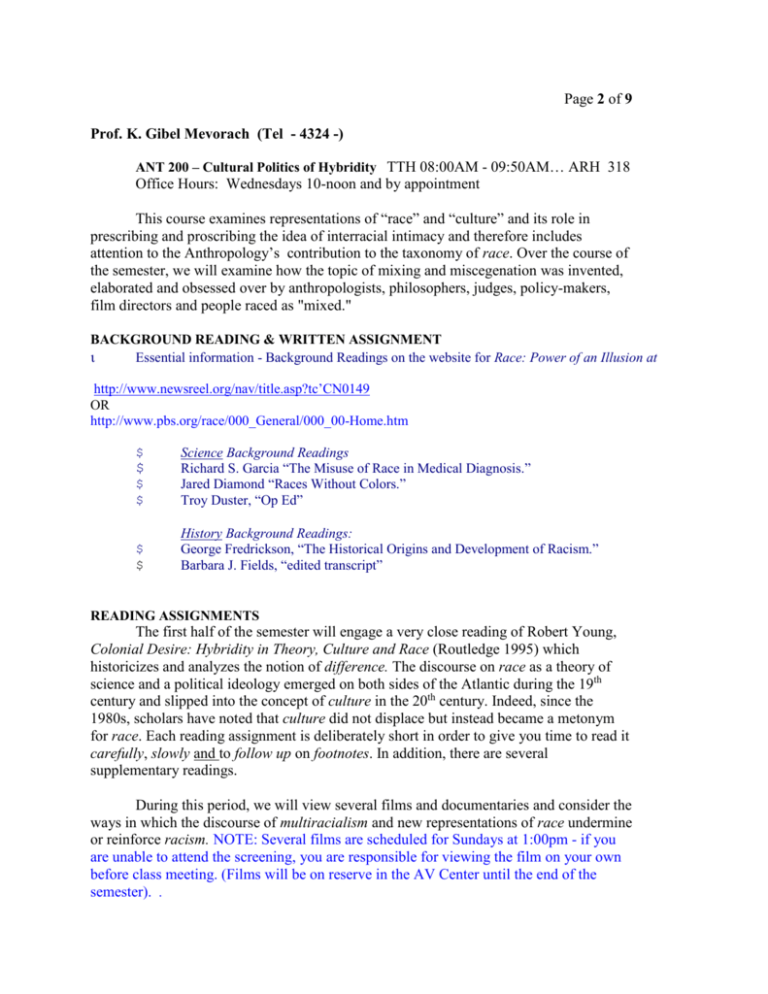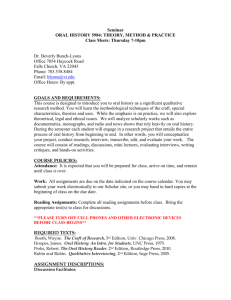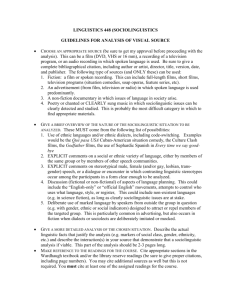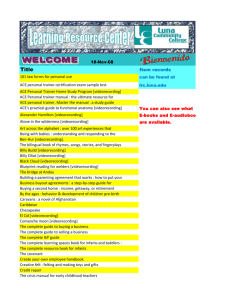ANT 200.01
advertisement

Page 2 of 9 Prof. K. Gibel Mevorach (Tel - 4324 -) ANT 200 – Cultural Politics of Hybridity TTH 08:00AM - 09:50AM… ARH 318 Office Hours: Wednesdays 10-noon and by appointment This course examines representations of “race” and “culture” and its role in prescribing and proscribing the idea of interracial intimacy and therefore includes attention to the Anthropology’s contribution to the taxonomy of race. Over the course of the semester, we will examine how the topic of mixing and miscegenation was invented, elaborated and obsessed over by anthropologists, philosophers, judges, policy-makers, film directors and people raced as "mixed." BACKGROUND READING & WRITTEN ASSIGNMENT Essential information - Background Readings on the website for Race: Power of an Illusion at http://www.newsreel.org/nav/title.asp?tc’CN0149 OR http://www.pbs.org/race/000_General/000_00-Home.htm $ $ $ Science Background Readings Richard S. Garcia “The Misuse of Race in Medical Diagnosis.” Jared Diamond “Races Without Colors.” Troy Duster, “Op Ed” $ $ History Background Readings: George Fredrickson, “The Historical Origins and Development of Racism.” Barbara J. Fields, “edited transcript” $ READING ASSIGNMENTS The first half of the semester will engage a very close reading of Robert Young, Colonial Desire: Hybridity in Theory, Culture and Race (Routledge 1995) which historicizes and analyzes the notion of difference. The discourse on race as a theory of science and a political ideology emerged on both sides of the Atlantic during the 19th century and slipped into the concept of culture in the 20th century. Indeed, since the 1980s, scholars have noted that culture did not displace but instead became a metonym for race. Each reading assignment is deliberately short in order to give you time to read it carefully, slowly and to follow up on footnotes. In addition, there are several supplementary readings. During this period, we will view several films and documentaries and consider the ways in which the discourse of multiracialism and new representations of race undermine or reinforce racism. NOTE: Several films are scheduled for Sundays at 1:00pm - if you are unable to attend the screening, you are responsible for viewing the film on your own before class meeting. (Films will be on reserve in the AV Center until the end of the semester). . Page 3 of 9 WRITING ASSIGNMENTS Weekly Journal: (30%) The first half of the semester may be intense -- you will be acquiring new information and a historical context for understanding how desire/disgust shaped a trans-Atlantic white Christian European academic inquiry, policies and public attitudes towards notions of purity and mixing. Robert Young (Colonial Desire) offers an analysis that subjects anthropological ideas about culture to careful scrutiny and calls into question contemporary theories of post-colonialism and ethnicity. (Recommendation: schedule a quiet 2-3 hr session to prepare readings). Every student must keep a reading journal which outlines the main points of each chapter and highlights important footnotes. Each entry represents a conversation with the text, the author and class discussions. Commentary included with your outline should include reflections on: What did you learn? What were the main points? What is the significance of the chapter? How does it build on the previous chapter? What new information or questions are raised which offer you ideas that can be applied to other courses you have or are currently taking? Reflection papers on Films (20%): The selection of commercial films and documentaries register various popular and unpopular perspectives intended to influence the viewing audience. You will keep a separate set of entries on the films (commercial, independent, made for TV and documentaries). Your 2-3 page film reflections should draw on insights gained cumulatively from the readings - they should not model a film critic’s review. Instead, focus should be on the messages, images, stereotypes, etc which seem projected to a contemporary audience: Who does the target audience appear to be? What information is conveyed? How are traditional notions of purity and mixing re-enforced or undermined in each film? Whose political concerns are addressed? Is the focus on individual, community or national identity? Are multiple identities projected? How are individual agency and institutional structures balanced in the films? Journals are to be dated and paginated Your ideas will not be graded as "correct" or "incorrect" -- rather this is an opportunity to review, explore, and engage with ideas, historical information, theoretical approaches, and new articulations. Format for typing your entries: $ Left Margin 1.5", Right Margin 1." $ Double spaced and standard font. $ Pages must be numbered sequentially. (first entry is p1. so end of semester will be p.xxx) $ Entries must be dated (the dates are for you to review the development of your thoughts at the end of the semester.) The journal entries count toward your final grade but will not receive individual grades.* Journal entries are due on Mondays by noon without exception (excluding medical or family emergencies). Page 4 of 9 Final Paper (30%) The culminating project for this course will be a 8-10 page essay, informed by the readings, which addresses Robert Young’s concluding question: why do our own forms of racism remain so intimately bound up with sexuality and desire? Considering the context of the U.S. American black/white binary as a point of departure, in what ways do racial identities conform, compromise and confound contemporary ideas about racial difference? What are the political implications for celebrating racial diversity and racial mixing in terms of power and distribution of resources? What role do questions of racism, as a political phenomenon, occupy in the discourse on Amixed race” people? This paper should have a title page and a bibliography which draws extensively from the bibliographical references in the texts of the semester. There are no foolish questions; only foolish silence Leading Discussions (15%) For each class, three students will be responsible for writing and distributing an outline of key points for class distribution. This group will also discuss the main argument(s) of an essay (or chapter): how and why the reading is significant to the key themes or topics under discussion? How are issues linked to previous readings and class discussions? Outline should include page references: group will highlight specific passages and comment on them as well as raise questions for discussion - the group is responsible for addressing these questions in their presentation and then opening them up for class discussion. Each presentation should take 15-20 minutes. read the guideline again because you will be interrupted if you ramble or are unprepared. Class Discussions (5%): It is appropriate for there to be differences of opinion, disagreement and debate. This furthers our own understanding of the topic and requires both review and clarification of perspectives. This class provides the opportunity to engage with a perspective which is in opposition to your own. NOTE: Consensus is not the purpose of class discussion! Each of you is responsible for overcoming the urge to be silent rather than to disagree, or to be constrained by the silencing effect of obsessive politeness. Your efforts should be directed toward developing an informed perspective which serves as a basis for analysis and articulation. Active engagement through discussion helps to sharpen how you articulate your ideas - therefore, being challenged through discussion helps you refine the ways in which you articulate these ideas. Critical thinking and exchanging ideas depends on listening carefully to another person's perspective and responding respectfully as well as effectively. The focus should be specifically on what and why there are points of agreement or disagreement -- what differentiates interpretations and in what ways is one more or less persuasive than Page 5 of 9 another? Personal experience is important but it should neither be generalized nor serve as an epistemological foundation. Instead you may draw on it as an additional resource -not a substitute -- for information or evidence from the texts we will be reading. In other words, your arguments always need to be situated within the context of the assigned readings although they may also be supplemented with outside sources. You should therefore always back up your comments with reference to the texts and specific passages and page numbers (hence the notes you bring to class are important)! GRADING POLICY: focus on learning as a process and act as your own judge. If you want to know how you are doing, make an appointment to visit with me: my first question will be, “how would you evaluate your work? What do you think of your work and contribution to class discussions? Where do you see room for improvement? What are your plans for improving your work to your satisfaction?” You must keep a folder with three sections for each of your written material (journal entries; film evaluations; final paper) which will be re-submitted at the end of the semester in a stamped, self-addressed envelope. Do not reprint. If you will be back on campus in Spring semester, you may use your campus mailbox as the returning address. ALL WRITTEN WORK AND FINAL PAPER in stamped self-addressed envelope ARE DUE: MONDAY 14 DECEMBER BY 1:00 PM -- THERE ARE ABSOLUTELY NO EXTENSIONS - in case of emergency or extenuating circumstances, you must go through the Registrar’s Office, request an incomplete and get an official extension. (Don’t even ask: this is non-negotiable). Page 6 of 9 WEEKLY SCHEDULE 27/8 Thursday – Introductions; Read http://www.census.gov/population/www/socdemo/race/Ombdir15.html http://www.ornl.gov/hgmis/ Bring (typed) answers to the following questions (not to exceed 2 pages): (1) Why did the U.S. Census continue collecting racial data in its 2000 census? (2) What is the difference between subjective self-identification & personal identity and group identification & public identity? (3) Making meaning: define the difference between the noun “race” and the verb “ race.” Highlight in text & bring to class the exact passage(s) quoting Office of Management & Budget (OMB) explanation for the continued use of racial categories on the U.S. Census. (Point: what information is needed and for what purpose?) ARH 305 SAT 29AUG 10:00 AM - AFRICANS IN AMERICA part 1 & 2 SUN 30 AUG 2:15 PM - AFRICANS IN AMERICA part 3 & 4 “Africans in America [videorecording] : America's journey through slavery.” / produced for PBS by WGBH Boston ; produced and directed by Orlando Bagwell, Susan Bellows ; writer, Steve Fayer 1/9 Tuesday Selections from: Harriet Jacobs (JSTOR) Sidney Kaplan, “The Miscegenation Issue in the Election of 1864" Journal of Negro History 34, 3 pp. 274-343. (Pioneer Web) Peter W. Bardaglio, “Shamefull Matches: The Regulation of Interracial Sex and Marriage in the South Before 1900.” In ed. Martha Hodes, Sex, Love, Race (Pioneer Web)Werner Sollors, “Appendix B: Prohibitions of Interracial Marriage and Cohabitation”: Crossing Boundaries in North American History 3/9Thursday 4 ARTICLES ON JSTOR: Andrew D. Weinberger. “A Reappraisal of the Constitutionality of Miscegenation Statutes.” The Journal of Negro Education 26, 4 (Autumn 1957), 435446. Richard H. Steckel. “Miscegenation and the American Slave Schedules.” Journal of Interdisciplinary History 11, 2 (Autumn 1980), 251-263. Pegge Pascoe. AMiscegenation Law, Court Cases, and Ideologies of >Race’ in Twentieth. Century America.” The Journal of American History 83, 1 (Jun 1996), 44-69. Victoria E. Bynum. “>White Negroes’ in Segregated Mississippi: Miscegenation, Racial Identity, and the Law.” The Journal of Southern History 64, 2 (May 1998), 247276 Week 2 SUN 6/9 -- 1:30 pm ARH 224 Page 7 of 9 Film: South Pacific [videorecording] / a South Pacific Enterprises, Inc. production (1958) ; produced by Buddy Adler ; directed by Joshua Logan (150 min) 8/9 Tuesday David A. Hollinger. “Amalgamation and Hypodescent: The Question of Ethnoracial Mixture in the History of the United States Amalgamation and Hypodescent: The Question of Ethnoracial Mixture in the History of the United States.” The American Historical Review, Vol. 108, No. 5 (Dec., 2003), pp. 1363-1390. (JSTOR) Barbara J. Fields. “Of Rogues and Geldings Of Rogues and Geldings.” The American Historical Review, Vol. 108, No. 5 (Dec., 2003), pp. 1397-1405. (JSTOR) 10/9 Thursday -- Hybridity & Diaspora R. Young Colonial Desire: -- pp. xi-22 Week 3 15 /9 Tuesday -- R. Young pp. 22-29 17/9 Thurs Culture & the History of Difference R. Young pp. 29-43 Fri eve – Sun eve Rosh HaShana Week 4 22/9 Tues R. Young pp. 43-54 24/9 Thurs R. Young pp. 55-72 Documentary in class: The life and times of Sara Baartman "The Hottentot Venus." New York, N.Y. : First Run/Icarus Films, [1998] Week 5 (Sun eve – Mon eve Yom Kippur) 29/9 Tues The Complicity of Culture R. Young pp. 72-89 1/10 Thurs Sex and Inequality R. Young pp. 90-109 Week 6 SUN 4/10-- 1:30 pm ARH 224 Film: Band of Angels (1957) 6/10 Tues R. Young pp.109-117 8/10 Thurs Colonial Desire: Egypt in America R. Young pp. 118-141 Week 7 SUN 11 Oct -- 1:30 pm ARH 224 Film: A Family Thing (1995) 13/10 Tuesday R. Young Colonial Desire White Power, White Desire pp. 142-158 and Colonialism and the Desiring Machine 159-182 15/10 Thursday – Page 8 of 9 Groups meet to discuss questions for journal paper (due in class, at 8:00 am, on 27/10): Mid-Semester Journal Paper (6-8 pp) on Colonial Desire - should include: discussion of the two final chapters how do the opening and closing chapters relate to each other? summary of what you learned from the book as a whole, in what ways it intersects with other courses you are taking this semester (in theme and in era) Write a reflection on Robert Young’s concluding question: why do our own forms of racism remain so intimately bound up with sexuality and desire? FALL BREAK – Week 8 27/10 Tuesday -- After-Break 7:30 am Breakfast Meeting with Film EBSCO: Gordon, Lewis R. (1995) “Critical Mixed Race.” Social Identities 1, 2 Film in class-- Broken Lance (1954) [Relate the 1954 film and Lewis Gordon’s 1995 comments – look up Hays Code & information on Katy Jurado] 29/10 Thursday In Class documentary: Ethnic man! [videorecording] / Entertaining Diversity presents ; written, produced and directed by Teja Arboleda, Barbara Wilson Arboleda Imprint Evanston, IL : Distributed by AGC/United Learning, c2000 (35 min)Ethnic Man (35 min) (Pioneer Web) Matthew Frye Jacobson, “History, Historicity, and the Census Count by Race.”eds. Perlmann and Waters. The New Race Question: How the U.S. Census Counts Multiracial Individuals” (Pioneer Web) Margo Anderson, “Counting by Race.” Nathan Glazer, “Reflections on Race, Hispanicity and Ancestry in the U.S. Census;” Clyde Tucker et al. “Comparing Census Race Data under the Old and the New Standards.” Week 9 1/11 SUN -- 1:30 pm ARH 224 A House Divided (screened on Showtime TV 2000) Avnet/Kerner production in association with Atkinson Way ; produced by Beth Colt, Sam Waterston ; screenplay by Paris Qualles ; directed by John Kent Harrison; Paramount Pictures, 2000 (NOTE advert blurb: A young woman growing up on her father's plantation is unaware that her mother is one of the black servants, and when the truth is revealed, she and her mother are thrown into a storm of lies and hate) http://www.imdb.com/title/tt0241147/ for reviews, details etc. 3/11 Tuesday Read on Lexis Nexis the case of Amanda America Dickson (1887): Go to “Get a Case”: Smith v. Du Bose, 78 Ga. 413 1887 - carefully read the judicial decision. Read (Pionner Web) Josephine Boyd Bradley and Kent Anderson Lelise “White Pain Pollen: An Elite Biracial Daugher’s Quandry.” In Martha Hodes, Sex, Love, Race: Crossing Boundaries in North American History ROUNDTABLE DISCUSSION (1) Context: what were key political events when Pinky, Broken Lance, Band of Angels and A House Divided were respectively released in 1949 - 1954 - 1957 - 2000? (You will need to ask for assistance from a reference librarian!) Page 9 of 9 (2) Consider the representation of Julia Dickson and Amanda Dickson in A House Divided and their characterization as registered in the judicial decision? (3) What messages and ways of thinking “about” identities (as well as about memory, history and group identities) seem to have been conveyed to audiences? What shifts do you see in the cinematic representations of “mixed race” and its role in (i) mirroring and (ii) teaching about “race thinking” to US American audiences? (iii) Why is context and contextualization important to a critical analysis of these four films? 5/11 Thursday Documentary Doubles [videorecording] : Japan and America's intercultural children / produced and directed by Regge Life (Lexis database - Legal) Hirishi Karthikeyan and Gabriel J. Chin. “Preserving Racial Identity: Population Patterns and the Application of Anti-Miscegenation Statutes to Asian Americans, 1910-1950.” Asian Law Journal 9 (May 2002) (Pioneer Web) Henry Yu “Mixing Bodies and Cultures: The Meaning of America’s Fascination with Sex between ‘Orientals’ and ‘Whites.” In ed. Martha Hodes, Sex, Love, Race: Crossing Boundaries in North American History Week 10 Sunday 8/11 -- 1:30 pm ARH 224 Film The Nephew 10/11 Tuesday Mary Luke, Carmen and Luke, Allan. “Theorizing interracial families and hybrid identity: An Australian perspective.” Educational Theory; Spring99, Vol. 49 Issue 2, p223 (EBSCO) 12/11 Thursday Teng, Emma. “Eurasian Hybridity in Chinese Utopian Visions: From "One World" to "A Society Based on Beauty" and Beyond.” positions: east asia cultures critique, Volume 14, Number 1, Spring 2006, pp. 131-163 (Project Muse) Week 11 17/11 Tuesday Lee. “Mixed Race Peoples in the Korean National Imaginary and Family.” Korean Studies, Volume 32, 2008, pp. 56-85 (Project Muse Article) Jin Haritaworn. “Caucasian and Thai make a good mix'.” European Journal of Cultural Studies. 12, 1 (2009), 59-78. (Pioneer Web) 19/11 Thursday Hoffnung im Herz [videorecording] ‘ Hope in my heart : mündliche Poesie : May Ayim / Regie, Maria Binder ; Produktion, Dagmar Schultz, Maria Binder (29 min) Joachim Warmbold (1992), “If Only She Didn’t Have Negro Blood in Her Veins: The Concept of Metissage in German Colonial Literature.” Journal of Black Studies 23, 2, pp. 200-209 (JSTOR) (Pioneer Web) C. Blanckaret, “Of Monstrous Métis: Hybridity, Fear of Miscegenation, and Patriotism from Buffon to Paul Broca.” In the Color of Liberty Week 12 24/11 Tuesday In Class: Afroargentines (75 min) "A film which unearths the hidden history of black people in Argentina and their contributions to Argentine culture and society, from the slaves who fought in the Page 10 of 9 revolutionary wars against Spain, to the contemporary struggles of black Argentines against racism and marginalization. ... [It] provides a counternarrative to the national myth of Argentina's exclusively European heritage."--Container READ: (Pioneer Web) Melissa Nobles, “Lessons from Brazil.” In The Color of Liberty eds. (Pioneer Web) Joscelio Teles dos Santos, “A Mixed-Race Nation: AfroBrazilians and Cultural Policy in Bahia, 1970-1990.” IN Afro-Brazilian Culture and Politics ed. Hendrik Kraay Thanksgiving Thursday Week 13 -1/12 Tuesday K. Gibel Azoulay -- Prelude & Perspectives 3/12 Thursday K. Gibel Azoulay -- Contexts, Social Categories & Conditions of Possibility Week 14 -- KGA 8/12 Tuesday K. Gibel Azoulay-- Chpt 3 & 4 10/12 LAST CLASS MEETING K. Gibel Azoulay – Coda Your folder with three sections for semester’s written material (journal entries; film evaluations; final paper) should be re-submitted in a stamped, self-addressed envelope. Do NOT reprint. If you will be back on campus in Spring semester, you may use your campus mailbox as the returning address. ALL WRITTEN WORK AND FINAL PAPER DUE: MONDAY 14 DECEMBER BY 1:00 PM -- THERE ARE ABSOLUTELY NO EXTENSIONS.







